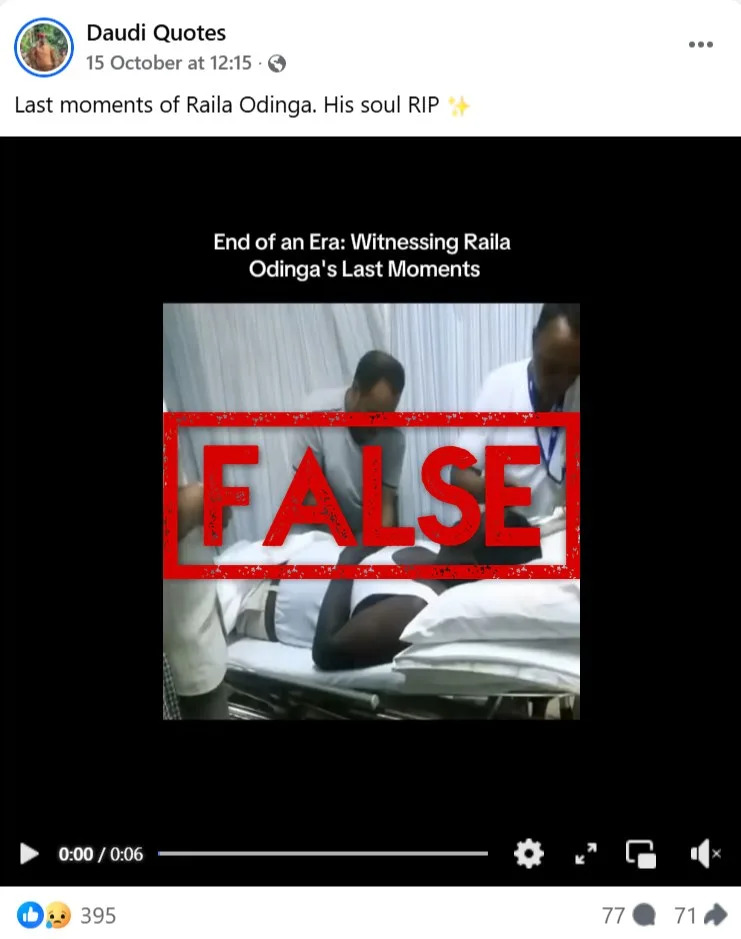On October 15, 2025, former Kenyan Prime Minister Raila Odinga passed away due to cardiac arrest while receiving treatment in Kerala, India. His death at the age of 80 sparked a wave of misinformation across social media platforms, with users circulating videos and images falsely claiming to depict his last moments. These posts not only misidentify individuals and locations but also include content generated through artificial intelligence.
Odinga, affectionately referred to as “Baba” by his supporters, had a significant political career in Kenya. He was the leader of the Orange Democratic Movement (ODM) and played a crucial role in the country’s transition to multiparty politics in the 1990s. Following his death, his body was returned to Kenya, where crowds estimated in the tens of thousands gathered at the airport to pay their respects. In response, President William Ruto declared a seven-day national mourning period, during which Odinga’s body lay in state at the Kenyan parliament, followed by public viewings in Nairobi and Kisumu. Tragically, at least five individuals died, and dozens more were injured due to crowd surges during these mourning events.
Odinga’s state funeral took place on October 19 at his family homestead in Bondo, western Kenya, attended by numerous dignitaries from across Africa and conducted with full military honors.
False Claims and Misinformation Spread
In the wake of Odinga’s death, a range of false claims emerged online. One particularly misleading video surfaced hours after the announcement, purportedly showing Odinga on his hospital bed, covered with a white sheet. The video claimed to depict his final moments with the caption, “End of an Era: Witnessing Raila Odinga’s Last Moments.” However, an investigation by AFP revealed that this footage was manipulated. A reverse image search indicated that the original photo was taken in 2017, when Odinga was hospitalized for dehydration.
Evidence suggests that the clip was created using AI tools, as the initial frame perfectly matched the original photo, a common technique in photo-to-video transformations. Additionally, noticeable deformities in the medical staff’s fingers and inconsistencies in the clothing further revealed the video’s artificial origins.
Another misleading clip circulated on social media, claiming to show Odinga’s widow, Ida Odinga, mourning at their family home in Bondo. This was also proven false; she was at their residence in Nairobi the morning of his death and arrived in Bondo only on October 18. Investigations confirmed that the woman in the video was not Ida Odinga, but rather a local mourner.
Further Misleading Content and AI Manipulations
As the days progressed, more false content emerged. A clip depicting mourners reportedly flooding the streets of Kisumu was shared, with claims it was in honor of Odinga. However, reverse image searches revealed that this footage was from a protest in Haiti in 2019, not linked to Odinga’s passing.
Additionally, images purporting to show vigils in Kisumu and an Aerial view of Jomo Kenyatta Stadium were found to be AI-generated. A TikTok account known for producing such visuals was identified as the source of these images, further complicating the narrative surrounding Odinga’s death.
While the public mourning for Raila Odinga was marked by genuine grief and significant attendance, the propagation of misinformation highlights the challenges in the digital age. As communities come together to honor the legacy of a prominent leader, the spread of false narratives serves as a reminder of the need for vigilance in verifying information, especially during times of collective sorrow.
